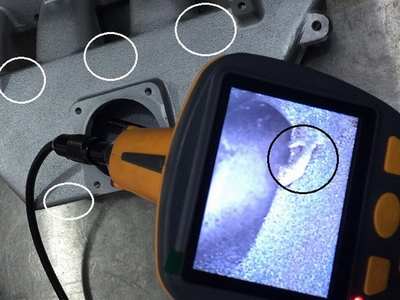Steel castings are often subject to inspections to verify specific physical properties such as dimensional accuracy, cast surface finish condition, and internal soundness.
In addition, chemical composition must also be inspected. Chemical composition is dramatically affected by minor alloying elements added to the material. Cast steel alloys are susceptible to variations of their chemical composition, so chemical analyses are required to verify the exact chemical composition prior to casting. A small sample of molten metal is poured into a mold and analyzed.
Dimensional accuracy
Dimensional inspections are carried out to make sure that the castings produced meet the customer's dimensional requirements and tolerances including allowances for machining. It may sometimes be necessary to destroy sample castings to take measurements of interior dimensions.
Surface finish condition
Casting surface finish inspections are employed to explore the aesthetic appearance of castings. They look for flaws in the surface and sub-surface of the castings that may not be obvious visually. The surface finish of a steel casting may be influenced by the type of pattern, molding sand, and mold coating used, as well as the weight of the casting and methods of cleaning.
Internal soundness
All castings have some level of defects present, and the soundness specification determines the acceptable defect threshold. Over-specification of the maximum allowable defect level will lead to higher scrap rates and higher casting costs. Under-specification of the maximum allowable defect level can lead to failure.

Inner Wall Inspection by Endoscopes
Three common internal defects that occur in steel castings are:
1. Porosity
Voids in the steel casting that are characterized by smooth, shiny interior walls. Porosity is generally a result of gas evolution or gas entrapment during the casting process.
2. Inclusions
Pieces of foreign material in the casting. An inclusion can be metallic, intermetallic, or non-metallic. Inclusions can come from within the mold (debris, sand, or core materials), or can travel into the mold during the pouring of the casting.
3. Shrinkage
Vacancy or area of low density typically internal to the casting. It is caused by a molten island of material that does not have enough feed metal to supply it during the solidification process. Shrinkage cavities are characterized by a rough crystalline interior surface.
Chemical analysis
Chemical analysis of cast steels is usually performed by wet chemical analysis methods or spectrochemical methods. Wet chemical analysis is most often used to determine the composition of small specimens, or to verify product analysis post-production. Contrastingly, analysis with a spectrometer is well-suited to the routine and rapid determination of the chemical composition of larger samples in a busy production foundry environment. Foundries can undertake chemical analysis at both the heat and product level.
|
